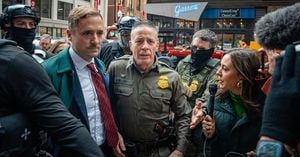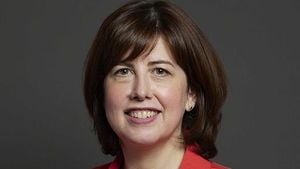With the November 2025 elections just days away, the national conversation is heating up over immigration policy, voting systems, and the ideological control of local institutions. From contested sheriff’s races in Pennsylvania to fiery rhetoric in Chicago’s City Hall, the issues at stake are as varied as they are consequential. Recent articles from Bolts and reporting by Warner Todd Huston have illuminated the complexities of these debates, providing a window into the political forces shaping the United States as voters prepare to head to the polls.
One of the most closely watched contests this fall is in Pennsylvania’s Bucks County, a swing region in the Philadelphia suburbs. Here, the sheriff’s race has become a flashpoint for the national debate over immigration enforcement. Republican Sheriff Fred Harran, who signed the county up for ICE’s 287(g) program earlier this year, faces Democratic challenger Danny Ceisler. The 287(g) program empowers sheriff’s deputies to act as federal immigration agents, a move that has divided voters. Ceisler has pledged to quickly terminate the contract if elected, a promise that highlights the sharp contrasts on immigration policy at the local level. As Bolts reported, Bucks is the only county this year with a contested sheriff’s race tied to 287(g), making it a bellwether for similar debates nationwide.
Immigration remains a hot-button issue far beyond Pennsylvania. In Chicago, Mayor Brandon Johnson has taken an unapologetically progressive stance, rejecting the term “illegal aliens” as racist and dehumanizing. At a press event on October 25, Johnson declared, “We don’t have illegal aliens. I don’t know if that’s from some sort of sci-fi message that you wish you’ve had.” He continued, “Listen, the legal term for my people were slaves. You want me to use that term, too?” According to Warner Todd Huston, Johnson’s remarks came after a reporter questioned him about his administration’s spending on undocumented migrants. Johnson, who has long opposed ICE activities in Chicago, used the opportunity to draw a parallel between language used to describe migrants and the history of anti-Black racism in America. He posted a video of his comments to Instagram, captioning it, “This isn’t a sci-fi show. These are human beings. We will not abandon our humanity to score cheap political points.”
Johnson’s approach has not been without controversy. He has criticized the Trump administration’s immigration policies and suggested that ICE officers should be arrested for performing their duties—an order that his chief of police did not enforce. Johnson’s rhetoric often links opposition to undocumented migrants with anti-Black racism, arguing that the language and policies targeting migrants are part of a broader pattern of discrimination. Critics, meanwhile, accuse him of conflating distinct issues and failing to address concerns about crime, public resources, and the rule of law.
While immigration dominates headlines, the mechanics of voting itself are also under scrutiny. In New York City, this year’s general election on November 4 will use a conventional voting system rather than the ranked-choice voting (RCV) employed in the primaries. This distinction has sparked debate among voters and advocates. Susan Lerner, president of Common Cause New York, explained to Bolts that RCV was initially limited to primaries to avoid confusion with the city’s unique fusion voting system. Under fusion voting, candidates can appear on the ballot multiple times under different party lines, as is the case with Democratic mayoral nominee Zohran Mamdani, who is also running as the Working Families Party candidate. Lerner acknowledged, “We were concerned that, in the general, where a candidate’s name could appear two or three times on the ballot, it’d be confusing to the voter… In setting up a ranked-choice voting system, we knew that it’s necessary to have very effective and vigorous communication.” Still, she now believes it may be time to consider expanding RCV to general elections, given voters’ growing familiarity with the system.
School board races are another battleground where ideological control hangs in the balance. Across the country, from Colorado to Texas and Pennsylvania, voters will decide whether conservative or progressive majorities will govern local education policy. In one of Colorado’s largest districts, a right-wing majority that has opposed LGBTQ+ rights and undermined state health initiatives could lose its 4-3 edge. In Texas, the Cypress-Fairbanks school board, long dominated by the Christian right, faces a potential shift. Meanwhile, in Bucks County, Democrats hope to capture all seats on school boards that were once strongholds of the GOP. As Bolts notes, these races often fly under the radar, but their outcomes have profound implications for issues like book bans, LGBTQ+ student rights, and the broader culture wars playing out in American schools.
Judicial elections are also on the ballot, with Pennsylvania holding retention votes for three supreme court justices and two appellate judges. In these races, voters simply choose “yes” or “no” on whether to retain a judge, a process that is rarely competitive. Pennsylvania’s hybrid system, where justices first run in partisan elections and then face retention votes, is shared only with Illinois and New Mexico. Historically, justices are overwhelmingly retained, but recent years have seen exceptions as political polarization intensifies. As Bolts details, the outcome of these elections may offer clues about shifting voter attitudes toward the judiciary.
Amid these local and state contests, some observers are looking for signs of broader political realignment. Nathaniel Rakich, an elections analyst cited by Bolts, cautions against reading too much into off-year results, especially for high-profile gubernatorial races. “This is especially true for the big-ticket governors’ races; gubernatorial races in general tend to be more idiosyncratic and candidate-driven than any other type of election,” he said. Yet, special elections for legislative and congressional seats can provide predictive insights, particularly when viewed in aggregate. David Nir, editor of The Downballot, noted, “So far this year, Democratic candidates have performed an average of 15 points better than you’d expect. That’s strong—and even stronger than in the 2017-18 cycle, when Democrats took back the House.”
Historical context also shapes today’s races. The resurgence of progressive candidates like Zohran Mamdani in New York has drawn comparisons to Milwaukee’s “sewer socialism” era from 1910 to 1960, when municipal socialists prioritized public services and infrastructure. Historian Joshua Kluever told Bolts that while the term “sewer socialism” was originally a pejorative used by more radical leftists, Milwaukee’s socialists “did more than just fix the sewers… They built public parks, made the streetcar system safer, expanded the city’s port, and ensured safer working and living conditions for Milwaukee residents.” Kluever expects that Mamdani, if elected, will face criticism from the left for not going “far enough,” but argues that policies like rent caps and free buses are in line with the tradition of robust public service provision.
Finally, California’s Proposition 50 on the November ballot could have national ramifications, potentially impacting five congressional seats in 2026. While only four states are filling statewide offices this fall and turnout is expected to be lower than in midterms, analysts are watching closely for early signals of where American politics may be headed next.
As voters prepare to make their voices heard, the 2025 elections are shaping up to be a revealing snapshot of the nation’s divisions, priorities, and aspirations. From city halls to school boards and courtrooms, the choices made this November will echo far beyond Election Day.




